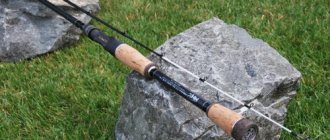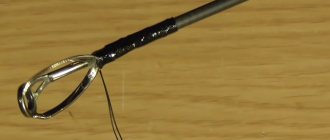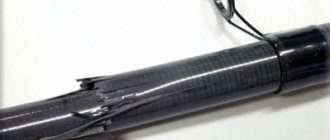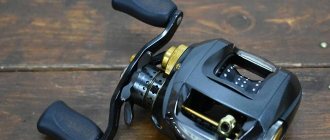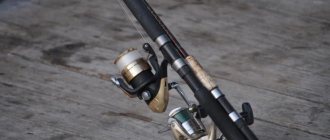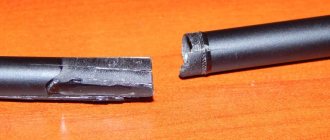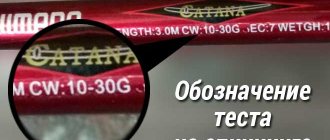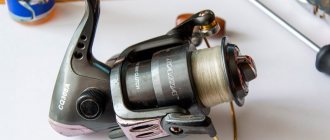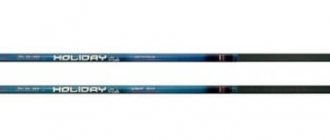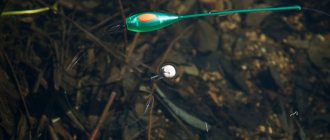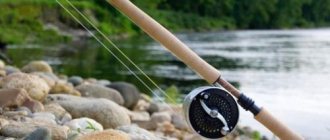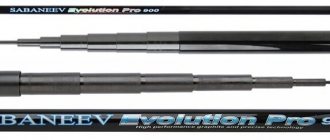Every angler has had troubles associated with spinning rod breakdowns, whatever one may say, but there are no eternal rods, sooner or later breakdowns happen.
Due to the complexity of manufacturing a modern spinning rod, it contains many structural elements that can break. Even the simplest fishing rod has guides, a handle and a flexible tip that are subject to wear. Not to mention the body of the rod itself, which suffers from improper transportation, damage from heavy objects and improper use.
There are several common breakdowns that you can fix yourself. It is not always possible to do this in fishing conditions, but you can improve the condition of the gear if you have some tools and materials.
Common spinning rod breakdowns:
- Fracture or damage to the tip.
- Damage to the guide rings.
- Damage to the rod knee.
- Damage to the rod handle.
Fracture of the tip in the middle
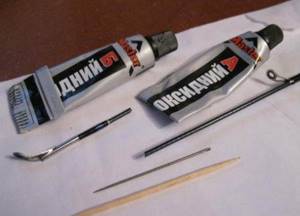
The fracture of the tip of the spinning rod in the middle is carried out by merging two halves. This also has its own nuances, because there are 2 types of tops, hollow inside and monolithic.
Hollow, just insert into the middle a sewing needle of a suitable diameter or a piece of rigid wire, thoroughly lubricated with epoxy resin or epoxy-based glue. You need to let it dry and rewind it tightly with a thin nylon thread, covering it with varnish for rigidity. Such a rod will firmly hold its shape, and the external winding will not allow the tip to break again.

Monolithic ones have a slightly different repair principle; you need to select a thin-walled metal tube; a piece of an old radio antenna works well. You need to degrease the broken parts, lubricate them with epoxy resin and insert the tube into the prepared piece so that both halves meet inside. If you leave a void there, most likely such a connection will simply break at the first load. You also need to varnish the entire connection and wrap it tightly with a thin nylon thread, cover it with a second layer of varnish on top and let it dry.
Fracture at the base and tip
Tops with a fracture at the base and at the tip are repaired with minimal noticeability, since it involves removing the broken part.
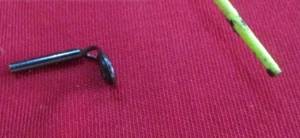
If the tip with the ring is broken off, then you need to heat the remains of the tip in the seat of the ring with a lighter, after which they can be easily removed. On the remaining part of the tip, the tip is cut off and leveled with a sharp knife, the diameter is approximately adjusted for the seat using sandpaper. Then it is mounted with epoxy resin, the end ring on the tip.
In case of a fracture at the base, you must also remove the ring from the top. Remove the plug at the base of the telescopic spinning rod and push the remains of the broken part of the top into the inside of the spinning rod. This way the residue will fall out at the bottom of the rod. For most of the broken top, you need to cut off all the irregularities in the area of the fracture and create a smooth, thick edge. Then apply a strip of varnish or epoxy resin, about one centimeter wide, to the tip of the thick edge of the tip. Using a thin nylon thread, wind 8-10 turns, carefully trim and apply varnish on top of the thread. This way we compensate for the thickness of the lost part of the tip, because it has a very inconspicuous conical shape. After the varnish has dried, you need to remove irregularities around the circumference of the turns using fine sandpaper. Then the tip needs to be pushed through the bottom of the spinning rod, in the reverse order as we removed the remaining debris. In the end, we get a slightly shortened tip that does not lose the functionality of folding with the rest of the spinning rod’s legs. Having placed the final passage ring on the glue, the repair can be considered complete.
The rod broke. How to improve the situation?
Most often, a spinning rod breaks. Don't rush to throw away the tackle. Use your wits and fix the damage. Of course, it will take time, but repairing the spinning rod is worth it.
Let's start to act:
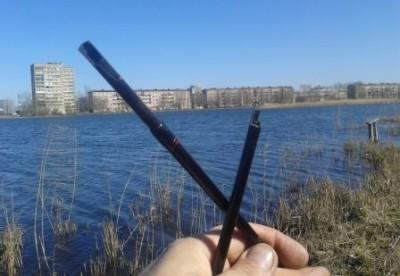
Attention! Of course, the rod will become a little shorter, and its test will also change, but this will not change the catchability of the tackle.
Repair of access ring
Another common type of failure relates to skip rings. Avid fishermen never go to a pond without tools and spare parts for a spinning rod, so they always have a spare ring in their bag.
If you don’t have a replacement with you, then the defective ring is simply removed. The tackle will not lose its fishing properties due to this.
Possible actions in case of a broken knee
A knee injury causes especially big trouble for fishermen. Spinning is quite an expensive pleasure, especially if it is branded. It would be a shame to throw it away and not practical.
You can contact a repair company and find out if it is possible to purchase an analogue of the broken element. Many companies that value their reputation never refuse such a request.
Another option is to contact a specialist who repairs spinning rods. But this is the case when the breakdown is noticed during preparation for fishing.
What if everything happened at the most inopportune moment, during fishing? Try to be smart and fix the tackle yourself.
- Using a sharp knife, you need to cut off the area where the breakage occurred. We do this carefully so as not to damage the other part of the rod.
- We find suitable fasteners so that they can be used to connect two adjacent elbows, having previously cleaned the joint with sandpaper. Lubricate the available material for joining with Moment glue.
- We wrap the formed knots on top with electrical tape or adhesive tape.
- If there is a copper tube of appropriate parameters, then it can be used as a coupling.
If the breakdown relates to the lower, thick knee, and the upper one is not damaged, you can change the profile of the spinning rod. The top leg can be a great fishing tool when fishing vertically from a boat.
To do this, you need to dismantle the lower ring on the knee and attach some kind of rod to it, wrapping the latter with any fastener: electrical tape, plaster.
Despite the fact that the formation will change, you can still fish.
What should a fisherman always have?
If the spinning reel breaks down, then you will have to forget about fishing and return home with nothing. But this should not be done, since in many cases you can fix the breakdown of an important element of fishing equipment yourself. But only if the damage is minor.
Important. A real fisherman, going to a pond, never leaves without taking everything necessary to eliminate possible malfunctions.
This also applies to repair kits for fishing gear. It is useful to stock up on such accessories that can be purchased at any store.
The most disgusting sound for an angler is the sound of a spinning rod breaking. Fishing can be ruined, and then the question arises: how to restore your favorite tackle? In this topic we will talk about repairing a broken spinning rod with your own hands.
I have been fixing fishing gear for a long time. During this time, I had to see various types of repairs, ranging from bandages made of titanium tubes, apparently made at a defense plant, and ending with nails glued into the form with superglue in the hope that such a structure would last at least a little. But making absolutely high-quality equipment repairs is not so difficult and is completely within the capabilities of a larger number of fishermen. This does not require scarce materials or tools. Naturally, a restored fishing rod will no longer delight you with its impeccable action or good design, but it can serve for many more years, for example, as a spare one. It hardly makes sense to repair a fiberglass spinning rod - it’s easier to buy a new one. But if you decide to repair it, you will need the most common materials: epoxy and fiberglass. But it’s worth tinkering with an expensive carbon fiber rod.
Damage to the guide rings
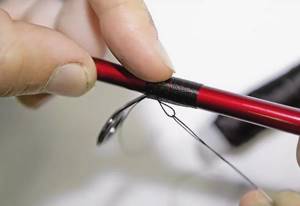
The breakdown is not critical, but unpleasant; in most cases, the guide rings simply peel off from the knees of the spinning rod. This problem can be solved either by applying a layer of epoxy resin and shrinking the pass ring over the entire place, or by rewinding it with a nylon thread and applying a layer of varnish.
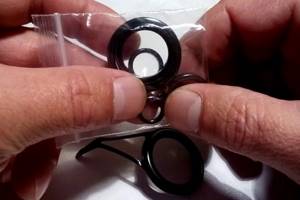
If the ring is destroyed, missing, or the ceramic liner has disintegrated, most likely such repairs will end with selecting a ring of the required diameter in a fishing store and replacing it with a new one.
Repair of a composite knee of a spinning rod
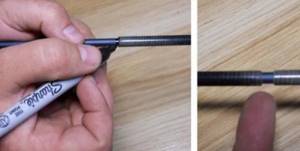
Fractures of composite rod knees are critical in most cases. They are restored using a metal sleeve, where the two broken parts need to be trimmed evenly, removing all signs of a fracture, and placed on epoxy resin, connected with a metal sleeve. Additionally, such a connection is varnished, wrapped in several layers of nylon thread and covered, for a durable connection, with a second layer of varnish or epoxy resin.
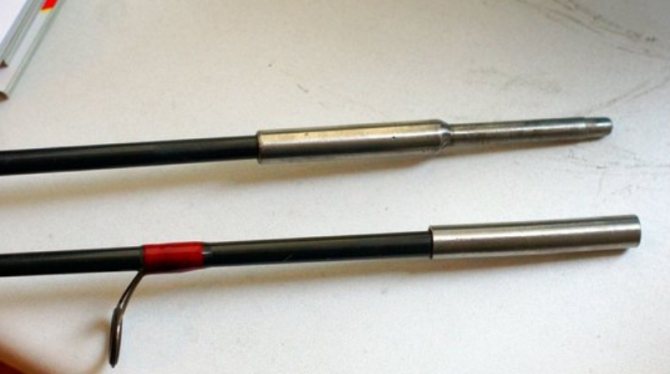
Also, if the fracture is in the middle of the knee, you can organize the connection as an integral part of the spinning rod. Thus, a broken leg in half will look like 2 composite rod legs. The connection is not difficult; just select two metal bushings that fit tightly into each other. Then adjust both broken parts to the diameter of the bushings and use epoxy resin to seat the bushings on both halves. Such tackle practically does not lose its structure, in places where the bushings shrink, you can also further strengthen the connection by winding nylon thread with a varnish coating.
Repair of the telescopic knee of a spinning rod
In most failures, the telescopic knee is severely damaged, accompanied by longitudinal cracks on a fairly large surface of the knee. The best solution would be to buy a suitable elbow from a fishing store, adjust it to the size of the spinning rod and replace it.
But some damage can still be repaired, it all depends on the characteristics of the damage.
Crushed knees, accompanied by small cracks, are easily restored. If there is deformation at the site of damage, this often happens if you carelessly place a heavy object on the rod. In this case, you need to heat the damaged area with a hairdryer and try to straighten the flattened area. Then cover the damaged area with a small layer of epoxy resin and wrap it with a slight tension, but in tight turns, with a nylon thread. Next, you need to re-apply epoxy to the thread and, as necessary, add a number of more turns of nylon thread. After drying, such a connection becomes very durable and allows you to keep your favorite gear in service.
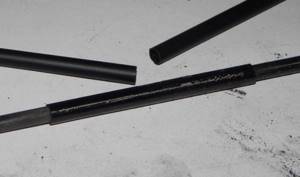
Fractures of the knees of a telescopic rod can be repaired using external and internal reinforcement. You can use a piece of a telescopic rod from an old tackle, suitable in diameter, using it in the form of a rod inside the knee, or the outer frame of the broken halves. This joint is installed on epoxy resin. It is strengthened by rewinding dense turns of nylon thread and applying epoxy resin or varnish on top.
Typical spinning rod failure
Almost 80% of plug spinning rods that need repairs have a broken upper leg, closer to the thin part. If the breakdown occurs in the area from the “tulip” to the first access ring, then the most common repair method is to move the “tulip” a little lower. Often your own “tulip” fits, and if not, you need to choose one that suits the seat. It is necessary to take into account that after the modification the rod will be stiffer, and its test will be due to an increase in the lower range of the thrown load, but the upper test will not change. In addition, the casting distance will inevitably decrease, since the rod will be shorter, and the best action will also be lost. A malfunction below the second ring will require a complete repair - applying a bandage with further finishing. Probably the most difficult case is the breakdown of the spinning rod in the connecting unit. It is very difficult to produce a complete and good bandage in this case. However, if the repair is successful, it will have almost no effect on the working properties of the fishing rod. If the upper elbow, which fits onto the lower one, breaks, you will need to make a mandrel, otherwise misalignment after repair is almost guaranteed, and the spinning rod will simply become crooked, and due to resin getting inside, the upper elbow will not be able to properly mate with the lower one. A temporary mandrel can be turned on a lathe from metal, hard wood, or from a suitable spinning rod elbow. The final fit is made by hand lapping. The geometric dimensions of the mandrel must completely fit the reciprocal (internal) lead-in part of the spinning rod. To prevent the mandrel from sticking tightly, it must be wrapped tightly, without folds or bubbles, with tape. Then apply a bandage to the repaired area using the technology described below. Once the resin has completely polymerized, the inner mandrel must be removed. If there is a breakdown of the internal part of the docking unit, then you will need to glue a tightly fitted carbon fiber monolithic rod inside.
Damage to the rod handle
The handles of spinning rods are usually made in the form of hollow attachments made of cork, synthetic material based on polypropylene, dense foam or foam rubber.
Damage to handles can be different - wear, cracks, mechanical damage. Repairing such handles is quite easy.
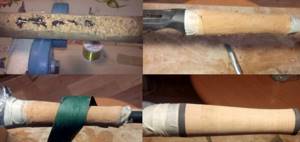
Cork handles can be repaired using wine or champagne corks. You need to grind the wine cork into small crumbs, prepare a little waterproof acrylic glue, mix the crumbs with glue and fill the damaged areas with this mixture using the putty method. After the glue has hardened, the repaired area must be sanded, forming a smooth overall structure of the handle.
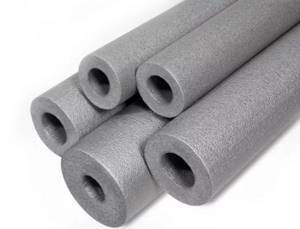
For polypropylene handles, a hardware store can find round insulation for water pipes that is suitable in diameter. You need to cut a piece of insulation to size and simply replace the damaged section of the handle.
In any case, if you really want to, you can repair the spinning rod using improvised means. But almost all parts of many spinning rod models are available in fishing stores. And in some cases, it’s still not worth inventing a sophisticated repair method by simply replacing the broken part.
We protect the spinning rod from damage
- Handle the spinning rod carefully and carefully. Be careful when transporting.
- After each active fishing, disassemble and clean the reel.
- After cleaning, be sure to lubricate.
It worsens the angler's mood, and sometimes even disrupts fishing. However, if you know some simple repair methods, then even on a pond you can successfully restore your gear.
No matter how carefully a fisherman treats his fishing rod, unexpected breakdowns often occur. They are especially inappropriate at the beginning of fishing. Many spinning rods are damaged during improper transportation when heavy things are thrown onto them. That’s why I advise you to get used to putting your gear on top of your luggage and using reliable cases or tubes.
More than one spinning rod has been broken while a fisherman was moving along a shore overgrown with bushes. Experienced ones are not afraid to spend a little time to move the fishing rod from a combat position to a transportable one. But such a measure will allow you to avoid tangling the fishing line, breaking the tips of the fishing rod, deforming the line brace, etc. But no matter how we protect our favorite spinning rod from breakage, trouble can happen to any angler and at any time. You need to prepare for this and not panic.
